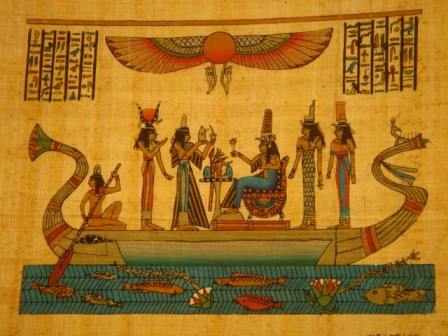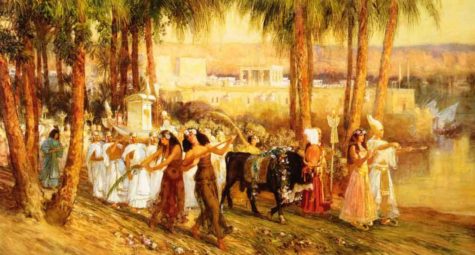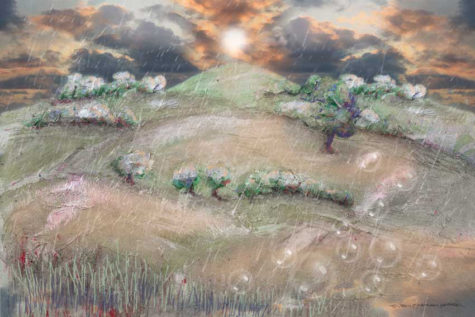Daily Archives: March 3, 2017
The Festival of Navigation (March 5th) was an ancient Roman festival that celebrated Isis as the ruler over safe navigation, boats, fishing, and the final journey of life. At this festival, after an elaborate parade, a Ship of Isis filled with great offerings of incense, flowers, libations and small shrines was sent out to sea.
For an eyewitness description of this festival, visit this post: Navigium Isidis.
I do like the idea of sending out ships with offerings to Isis. And with that in mind, I’m sharing here a video tutorial on how to make a paper boat that floats on water. This small boat could be decorated with symbols or with petitions for guidance, filled small offerings, and then floated down a stream, creek, river, etc. If you don’t have access to water, you could ritually burn your boat on a bed of incense and fragrant herbs and allow the smoke to take your petitions and offerings to the goddess.
When Egypt became part of the Roman Empire, Greek merchants brought the worship of Isis from Alexandria to Rome and invoked Her as inventor of the sail, patron of navigation, and ruler of the waves.
Possibly the most well known Isiac festival of the Roman world was the Navigium Isidis, celebrated on the 5th of March. As part of the festivities, a a festive carnival procession was performed in honor of Isis, and the Vessel of Isis, laden with offerings of precious spices and milk libations, is launched.
Here is a colorful and detailed eye-witness account of the procession and the ceremony:
Soon the sun of gold arose and sent the clouds of thick night flying; and lo, a crowd of people replenished the streets, filing in triumphal religious procession. It seemed to me that the whole world, independent of my own high spirits, was happy. The dusky clouds were routed; and the heavens shone with clear sheer splendor of their native light.
Presently the vanguard of the grand procession came in view. It was composed of a number of people in fancy dress of their own choosing; a man wearing a soldier’s sword-belt; another dressed as a huntsman, a thick cloak caught up to his waist with hunting knife and javelin; another who wore gilt sandals, a wig, a silk dress and expensive jewelry and pretended to be a woman.
Then a man with heavy boots, shield, helmet and sword, looking as though he had walked straight out of the gladiators’ school; a pretended magistrate with purple robe and rods of office; a philosopher with cloak, staff, clogs and billy-goat beard; a bird catcher, carrying lime and a long reed; a fisherman with another long reed and a fish hook.
Oh, yes, and a tame she-bear, dressed like a woman, carried in a sedan chair; and an ape in a straw hat and a saffron-coloured Phrygian cloak with a gold cup grasped in its paws – a caricature of Jupiter’s beautiful cup-bearer Ganymede.
Finally an ass with wings glued to its shoulders and a doddering old man seated on its rump; you would have laughed like anything at that pair, supposed to be Pegasus and Bellerophon. These fancy-dress comedians kept running in and out of the crowd, and behind them came the procession proper.
At the head walked women crowned with flowers, who pulled more flowers out of the folds of their beautiful white dresses and scattered them along the road; their joy in the Saviouress appeared in every gesture.
Next came women with polished mirrors tied to the backs of their heads, which gave all who followed them the illusion of coming to meet the Goddess, rather than marching before her.
Next, a party of women with ivory combs in their hands who made a pantomime of combing the Goddess’s royal hair, and another party with bottles of perfume who sprinkled the road with balsam and other precious perfumes; and behind these a mixed company of women and men who addressed the Goddess as “Daughter of the Stars” and propitiated her by carrying every sort of light – lamps, torches, wax-candles and so forth.
Next came musicians with pipes and flutes, followed by a party of carefully chosen choir-boys singing a hymn in which an inspired poet had explained the origin of the procession.
The temple pipers of the great god Serapis were there too, playing their religious anthem on pipes with slanting mouth-pieces and tubes curving around their right ears; also a number of beadles and whiffers crying: “Make way there, way for the Goddess!”
Then followed a great crowd of the Goddess’s initiates, men and women of all classes and every age, their pure white linen clothes shining brightly. The women wore their hair tied up in glossy coils under gauze head-dresses; the men’s heads were completely shaven, representing the Goddess’s bright earthly stars, and they carried rattles of brass, silver and even gold, which kept up a shrill and ceaseless tinkling.
The leading priests, also clothed in white linen drawn tight across their breasts and hanging down to their feet, carried the oracular emblems of the deity. The High Priest held a bright lamp, which was not at all like the lamps we use at night banquets; it was a golden boat-shaped affair with a tall tongue of flame mounting from a hole in the centre.
The second priest held an auxiliaria, or sacrificial pot, in each of his hands – the name refers to the Goddess’s providence in helping her devotees. The third priest carried a miniature palm-tree with gold leaves, also the serpent wand of Mercury. The fourth carried the model of a left hand with the fingers stretched out, which is an emblem of justice because the left hand, with its natural slowness and lack of any craft or subtlety, seems more impartial than the right. He also held a golden vessel, rounded in the shape of a woman’s breast, from the nipple of which a thin stream of milk fell to the ground. The fifth carried a winnowing fan woven with golden rods, not osiers. Then came a man, not one of the five, carrying a wine-jar.
Next in the procession followed those deities that deigned to walk on human feet. Here was the frightening messenger of the gods of Heaven, and of the gods of the dead: Anubis with a face black on one side, golden on the other, walking erect and holding his herald’s wand in one hand, and in the other a green palm branch. Behind, danced a man carrying on his shoulders, seated upright, the statue of a cow, representing the Goddess as the fruitful Mother of us all.
Then along came a priest with a box containing the secret implements of her wonderful cult. Another fortunate priest had an ancient emblem of her godhead hidden in the lap of his robe; this was not make in the shape of any beast, wild or tame, or any bird or human being, but the exquisite beauty of its workmanship no less than the originality of its design called for admiration and awe.
It was a symbol of the sublime and ineffable mysteries of the Goddess, which are never to be divulged a small vessel of burnished gold, upon which Egyptian hieroglyphics were thickly crowded with a rounded bottom, a long spout, and a generously curving handle along which sprawled an asp, raising his head and displaying its scaly, wrinkled, puffed-out throat…
Meanwhile the pageant moved slowly on and we approached the sea shore… There the divine emblems were arranged in due order and there with solemn prayers the chaste lipped priest consecrated and dedicated to the Goddess a beautifully built ship, with Egyptian hieroglyphics painted over the entire hull; but first he carefully purified it with a lighted torch, an egg and sulphur. The sail was shining white linen, inscribed in large letters with the prayer for the Goddess’s protection of shipping during the new sailing season.
The long fir mast with its shining head was now stepped, and we admired the gilded prow shaped like the neck of Isis’s sacred goose, and the long, highly-polished keel cut from a solid trunk of citrus-wood. Then all present, both priesthood and laity, began zealously stowing aboard winnowing-fans heaped with aromatics and other votive offerings and poured an abundant stream of milk into the sea as a libation.
When the ship was loaded with generous gifts and prayers for good fortune, they cut the anchor cables and she slipped across the bay with a serene breeze behind her that seemed to have sprung up for her sake alone. When she stood so far out to sea that we could no longer keep her in view, the priests took up the sacred emblems again and started happily back towards the temple, in the same orderly procession as before.
On our arrival the High Priest and the priests who carried the oracular emblems were admitted into the Goddess’s sanctuary with other initiates and restored them to their proper places. Then one of them, known as the Doctor of Divinity, presided at the gate of the sanctuary over a meeting of the Shrine-bearers, as the highest order of the priests of Isis are called. He went up into a high pulpit with a book and read out a Latin blessing upon “our liege lord, the Emperor, and upon the Senate, and upon the Order of Knights, and upon the Commons of Rome, and upon all sailors and all ships who owe obedience to the aforesaid powers.”
Then he uttered the traditional Greek formula, “Ploeaphesia”, meaning that vessels were now permitted to sail, to which the people responded with a great cheer and dispersed happily to their homes, taking all kinds of decorations with them; such as olive boughs, scent shrubs and garlands of flowers, but first kissing the feet of a silver statue of the Goddess that stood on the temple steps.
From: The Golden Ass
March 4th was the Greek festival of the Anthesteria, which was a celebration of flowers and dedicated to Flora. To celebrate this Spring festival of flowers, buy fresh flowers for your home. If you have house plants, repot and fertilize them. Burn a flowery incense, such as jasmine, rose or honeysuckle. Wear pastel colors to represent the delicate shades of the new Spring blossoms. Place a pretty bowl of fresh water on your altar and float a light flower in it.
When the moon is up, go to your altar and light a white candle. Sit in the darkness with only the candlelight. Look at the floating flower and think about the wonderful powers of Nature that bring the flowers back year after year. Contemplate the way this power touches your own life.
Feel your “roots” sinking deep down into the Earth, from which you can draw sustaining energy. Feel the energy being fed back to you. Now, reach your arms upward toward the Moon. Feel its energies adding to those of the Earth. Let these energies swirl around and through you, cleansing, healing, balancing. To break the flow, place both hands on the floor. Let the energies sink back into the Earth.
From: Moon Magick
This month was sacred to the Roman god Mars, hence the name March. Mars is similar to the Greek Ares, Tiu or Twaz of Central and Northern Europe, Teutates of the Celts, and Tyr of the Norse. The Roman goddess Bellona, goddess of war, had her special day during this month.
March is generally a blustery month weather-wise. The old weather saying “In like a lion, out like a lamb” is an apt description of March weather. For the Romans, it was the beginning of their year. The Spring Equinox, which falls around March 21 or 22, was a sacred and celebrated time in a great many world cultures. In the Southern Hemisphere, this would be equal to the Autumn Equinox, as the seasons are reversed. The Incas celebrated Pacha-puchy, or Earth Ripening, at this time.
The Roman Matronalia honored Juno Lucina, an aspect of the goddess Juno, who protected women, children and the family. Statues of the goddess were decorated with flowers, and special temple fires were lit. Girls made offerings to Juno Lucina at this time of year for happy and prosperous marriages.
The statue of Isis suckling her child symbolizes this goddess’s aspect as the Great Mother, the caretaker of the Earth and all life. Flowers were floated on the rivers and the boats blessed with incense.
In Canaan and other Semitic countries, the goddess Astarte was honored in a Spring celebration. Red eggs were given as gifts to family and friends, the beginning of our Easter egg tradition. Her sacred city of Byblos was noted for its extensive libraries before they were destroyed. As queen of heaven, Astarte wore crescent horns and was said to tirelessly create and destroy. The kings of Sidon ruled only with the goddess’s permission and called themselves the Priest of Astarte. Other cultures in the Middle East knew Astarte as Asherat of the Sea and Astart, queen of heaven.
Athene/Minerva,the armed goddess of wisdom,reigned over the biggest social event in Greece – the five day Spring competition featuring events in athletics, music, poetry and satire. Crowns of olive branches and flasks of olive oil were given to the winners of each event. On the final day, Athene’s birth was celebrated by draping the goddess’s statue in a new sacred garment.
This particular festival of Cybele, the Hilaria, was a happy time. Our word “hilarious” has similar word roots. The goddess Cybele can be compared to Demeter in many ways; Cybele represented the Earth as did Demeter and had a Spring resurrected son/lover Attis, who corresponded to Kore/Persephone. This happy festival celebrated the power of Cybele to overcome death.
Eostre was the German goddess of rebirth. Rabbits and colored eggs were fertility symbols connected with Her. Originally, Oestre was the goddess of the Spring Equinox whose name was changed to Easter by the Christians.
The Roman Luna, goddess of the Moon, was honored with the baking, exchanging, and eating of Moon cakes. Even the Chinese and Europeans knew of Moon cakes and some form of this goddess.
From: Moon Magick
Amaolikkervik Moon ~Inuit
Big Famine Moon ~Choctaw
Bud Moon ~Kiowa
Budding Trees Moon ~Medicine Wheel
Buffalo Calf Moon ~Arapaho, Sioux
Catching Fish Moon ~Agonquin
Chaste Moon ~Medieval English
Crow Moon ~Algonquin
Crane Moon ~Potawatomi
Crust Moon ~Algonquin
Deer Moon ~Natchez
Death Moon ~Neo-Pagan
Eagle Moon ~Cree
Fish Moon ~Colonial American
Green Moon ~Pima
Lenten Moon ~Cherokee
Little Frog Moon ~Omaha
Little Spring Moon ~Creek, Muscokee
Lizard Moon ~San Juan
Long Days Moon ~Wishram
Moon of Winds ~Celtic
Moose Hunter Moon ~Abenali
Much Lateness Moon ~Mohawk
Rain Moon ~Diegueno
Plow Moon ~Janic (full)
Sap Moon ~Algonquin
Seed Moon ~Janic (dark)
Snow Crust Moon ~Anishnaabe
Snow Sore Eyes Moon ~Dakota
Spring Moon ~Passamaquoddy
Strawberry ~Cherokee
Sugar Moon ~Algonquin
Whispering Wind Moon ~Hopi
Wind Strong Moon ~Taos
Windy Moon ~Cherokee
Worm Moon ~Algonquin








